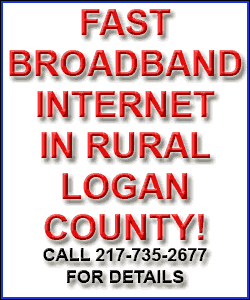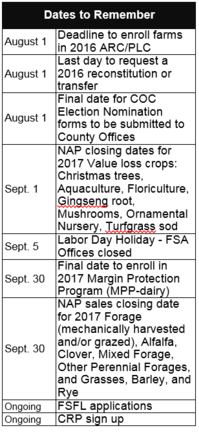|
 Although the choice between ARC and PLC is completed and remains
in effect through 2018, producers must still enroll their farm
by signing a contract each year to receive coverage. Although the choice between ARC and PLC is completed and remains
in effect through 2018, producers must still enroll their farm
by signing a contract each year to receive coverage.
Producers are encouraged to contact their local FSA office to
schedule an appointment to enroll. If a farm is not enrolled
during the 2016 enrollment period, producers on that farm will
not be eligible for financial assistance from the ARC or PLC
programs should crop prices or farm revenues fall below the
historical price or revenue benchmarks established by the
program.
Covered commodities include barley, canola, large and small
chickpeas, corn, crambe, flaxseed, grain sorghum, lentils,
mustard seed, oats, peanuts, dry peas, rapeseed, long grain
rice, medium grain rice (which includes short grain and sweet
rice), safflower seed, sesame, soybeans, sunflower seed and
wheat. Upland cotton is no longer a covered commodity.
For more details regarding these programs, go to
www.fsa.usda.gov/arc-plc.
For more information, producers are encouraged to visit their
local FSA office. To find a local FSA office, visit
http://offices.usda.gov.
Filing CCC-941 Adjusted Gross Income (AGI) Certifications
Many producers have experienced delays in receiving Agriculture
Risk Coverage (ARC) and Price Loss Coverage (PLC) payments, Loan
Deficiency Payments (LDPs) and Market Gains on Marketing
Assistance Loans (MALs) because they have not filed form
CCC-941, Adjusted Gross Income Certification. LDPs will not be
paid until all eligible producers, including landowners who
share in the crop, have filed a valid CCC-941.

Producers without a valid CCC-941 certifying their compliance
with the average adjusted gross income provisions will not
receive payments that have been processed. All farm
operator/tenants/owners who have not filed a CCC-941 and have
pending payments should IMMEDIATELY file the form with their
recording county FSA office. Farm operators and tenants are
encouraged to ensure that their landowners have filed the form.
FSA will be issuing potential 2015 ARC/PLC payments in October.
FSA can accept the CCC-941 for 2015 and 2016. Unlike the past,
producers must have the CCC-941 certifying their AGI compliance
before any payments can be issued.
Conduct USDA Business Online By Creating an eAuthentication
Account
The Internet allows you, the customer, access to USDA
information 24 hours a day, seven days a week. You can fill out
and submit electronic forms (eForms) any time of the day or
night from anywhere you have Internet access. This new service
delivery option allows you to complete and file your own forms
or applications online, because your signature is already
electronically "on file."
Information submitted to the Federal Government remains safe and
secure because every customer has a unique User ID and password;
only authorized USDA employees can access your information. It's
safe, saves paper, saves a visit to your local USDA Service
Center and provides electronic tracking of all your USDA
transactions.
How to Sign Up for eAuth :
Begin the process by reviewing the information at the USDA
Website https://www.eauth.usda.gov. This website describes the
services available for Level 1 and Level 2 Accounts. Level 1 and
Level 2 accounts require that you have an email address so you
can register, create a customer profile, and be able to respond
to a confirmation email. Level 1 Accounts do not require you to
provide proof of your identity at a local USDA Service Center.
Level 1 Accounts provide limited access to certain USDA Web site
portals that require no authentication or authorization. A Level
2 Account does require a visit to a USDA Service Center with
proof of your identity. That is because a Level 2 account allows
you access to complete and submit documents and forms
electronically.

LEVEL 1 ACCOUNT
STEP 1. To obtain a Level 1 Account, you may
self-register online at www.eauth.egov.usda.gov.
Scroll down and click on the button that says “Sign Up for a
Level 1 Account.” Complete the brief customer profile.
STEP 2. You will receive a confirmation email, and you
must respond to it within 7 days to activate your account.
LEVEL 2 ACCOUNT
STEP 1. To obtain a Level 2 Account, you must complete an
18 question customer profile and prove your identity by
presenting state or federal photo ID at a local USDA Service
Center. Go to www.eauth.egov.usda.gov, scroll down and click on
“Sign Up for a Level 2 Account.” Complete your customer profile,
which includes designating your user ID and password created by
you, contact information and email information. The data you
enter in your customer profile must match the data on the
document you use as identification at your local USDA Service
Center. Example: Your first and last names and address must
match the government-issued photo ID you plan to use to prove
your identity. Identify proof can only be verified by one of the
following documents: Current State Driver’s License, State Photo
ID, US Military ID, or United States Passport.
STEP 2. After completing your customer profile and
submitting it online, you will receive a confirmation email, and
you must respond to it within 7 days to activate your account.
STEP 3. Then you must complete the “Identify Proofing”
process by visiting a local USDA Service Center. You will be
required to present the eligible photo ID to an USDA employee
who will verify your identity and enter the expiration date of
the ID document used.
STEP 4. The USDA employee then will update your customer
profile to a Level 2 Account. You will have access to USDA
online applications and forms within one hour of your account
being updated.
You now have access to complete and submit documents and forms
electronically. USDA continues to update and make more forms and
programs available electronically.
Dairy Producers Can Enroll to Protect Milk Production Margins
USDA Farm Service Agency (FSA) in Illinois announced that dairy
producers can enroll for 2017 coverage in the Margin Protection
Program for Dairy (MPP-Dairy) starting July 1, 2016. The
voluntary program, established by the 2014 Farm Bill, provides
financial assistance to participating dairy producers when the
margin – the difference between the price of milk and feed costs
– falls below the coverage level selected by the producer.

The MPP gives participating dairy producers the flexibility to
select coverage levels best suited for their operation.
Enrollment began July 1, 2016 and ends on September 30, 2016,
for coverage in calendar year 2017. Participating farmers will
remain in the program through 2018 and pay a minimum $100
administrative fee each year. Producers have the option of
selecting a different coverage level during open enrollment each
year.
USDA has a web tool to help producers determine the level of
coverage under the MPP that will provide them with the strongest
safety net under a variety of conditions. The online resource,
available at www.fsa.usda.gov/mpptool, allows dairy farmers to
quickly and easily combine unique operation data and other key
variables to calculate their coverage needs based on price
projections. Producers can also review historical data or
estimate future coverage needs, based on data projections. The
secure site can be accessed via computer, Smartphone or tablet
24 hours a day, seven days a week.
To complete enrollment, producers must make coverage elections
during the enrollment period and pay the annual $100
administrative fee that provides basic catastrophic protection
that covers 90 percent of milk production at a $4 margin
coverage level. For additional premiums, operations can protect
25 to 90 percent of production history with margin coverage
levels from $4.50 to $8, in 50 cent increments. Once enrolled,
dairy operations are required to participate through 2018 by
making coverage elections each year. Producers can mail the
appropriate form to the producer’s administrative county FSA
office, along with applicable fees without necessitating a trip
to the local FSA office. If electing higher coverage for 2017,
dairy producers can either pay the premium in full at the time
of enrollment or pay 100 percent of the premium by Sept. 1,
2017. Premium fees may be paid directly to FSA or producers can
work with their milk handlers to remit premiums on their behalf.
Also beginning July 1, 2016, FSA will begin accepting
applications for intergenerational transfers, allowing program
participants who added an adult child, grandchild or spouse to
the operation during calendar year 2014 or 2015, or between Jan.
1 and June 30, 2016, to increase production history by the new
cows bought into the operation by the new family members. For
intergenerational transfers occurring on or after July 1, 2016,
notification to FSA must be made within 60 days of purchasing
the additional cows.

Dairy operations enrolling in the new program must meet
conservation compliance provisions and cannot participate in the
Livestock Gross Margin Dairy Insurance Program.
For more information, visit FSA online at www.fsa.usda.gov/dairy
or stop by a local FSA office to learn more about the Margin
Protection Program. To find a local FSA office in your area,
visit http://offices.usda.gov.
USDA Offers New Loans for Portable Farm Storage and Handling
Equipment
USDA’s Farm Service Agency (FSA) will provide a new financing
option to help farmers purchase portable storage and handling
equipment through the Farm Storage Facility Loan (FSFL) program.
The loans, which now include a smaller microloan option with
lower down payments, are designed to help producers, including
new, small and mid-sized producers, grow their businesses and
markets. The FSFL program allows producers of eligible
commodities to obtain low-interest financing to build or upgrade
farm storage and handling facilities.
The program also offers a new “microloan” option, which allows
applicants seeking less than $50,000 to qualify for a reduced
down payment of five percent and no requirement to provide three
years of production history, with CCC providing a loan for the
remaining 95 percent of the net cost of the eligible FSFL
equipment. Farms and ranches of all sizes are eligible. The
microloan option is expected to be of particular benefit to
smaller farms and ranches, and specialty crop producers who may
not have access to commercial storage or on-farm storage after
harvest. These producers can invest in equipment like conveyers,
scales or refrigeration units and trucks that can store
commodities before delivering them to markets. FSFL microloans
can also be used to finance wash and pack equipment used
post-harvest, before a commodity is placed in cold storage.
Producers do not need to demonstrate the lack of commercial
credit availability to apply for FSFL’s.
For larger farming and ranching operations that may not be able
to participate in the new “microloan” option, may apply for
larger FSFL’s with the maximum principal amount for each loan
through FSFL of $500,000.00. Participants are required to
provide a down payment of 15 percent, with CCC providing a loan
for the remaining 85 percent of the net cost of the eligible
storage facility and permanent drying and handling equipment.
Additional security is required for poured-cement open-bunker
silos, renewable biomass facilities, cold storage facilities,
hay barns and for all loans exceeding $100,000.00. FSFL loan
terms of 3, 5, 7, 10 or 12 years are available depending on the
amount of the loan. Interest rates for each term rate may be
different and are based on the rate which CCC borrows from the
Treasury Department.
Earlier this year, FSA significantly expanded the list of
commodities eligible for FSFL. Eligible commodities now include
aquaculture; floriculture; fruits (including nuts) and
vegetables; corn, grain sorghum, rice, oilseeds, oats, wheat,
triticale, spelt, buckwheat, lentils, chickpeas, dry peas sugar,
barley, rye, hay, honey, hops, maple sap, unprocessed meat and
poultry, eggs, milk, cheese, butter, yogurt and renewable
biomass.

Applications for FSFL must be submitted to the FSA county office
that maintains the farm's records. A FSFL must be approved
before any site preparation or construction can begin. To learn
more about Farm Storage Facility Loans, visit www.fsa.usda.gov/pricesupport
or contact a local FSA county office. To find your local FSA
county office, visit
http://offices.usda.gov.
Marketing Assistance Available for 2016 Wheat, Other Crops
The 2014 Farm Bill authorized 2014-2018 crop year Marketing
Assistance Loans (MALs) and Loan Deficiency Payments (LDPs).
MALs and LDPs provide financing and marketing assistance for
2016 crop wheat, as well as other commodities such as feed
grains, soybeans and other oilseeds, pulse crops, wool and
honey. MALs provide producers interim financing after harvest to
help them meet cash flow needs without having to sell their
commodities when market prices are typically at harvest-time
lows.
Illinois FSA county offices are now accepting requests for 2016
crop wheat, oats, barley and honey MALs and LDPs for eligible
commodities after harvest.
A producer who is eligible to obtain an MAL, but agrees to forgo
the loan, may obtain an LDP if such a payment is available.
In Illinois Hard Red Winter (HRW) prices are nearing a range
where LDPs may be applicable, so producers should become
familiar with the process to access this assistance.
To be eligible for an MAL or an LDP, producers must have a
beneficial interest in the commodity, in addition to other
requirements. A producer retains beneficial interest when
control of and title to the commodity is maintained. For an LDP,
the producer must retain beneficial interest in the commodity
from the time of planting through the date the producer filed
Form CCC-633EZ (page 1) in the FSA County Office. For more
information, producers should contact their local FSA county
office or view the LDP Fact Sheet.
USDA Offers Targeted Farm Loan Funding for Underserved Groups
and Beginning Farmers
The USDA Farm Service Agency (FSA) reminds producers that FSA
offers targeted farm ownership and farm operating loans to
assist underserved applicants as well as beginning farmers and
ranchers.
USDA defines underserved applicants as a group whose members
have been subjected to racial, ethnic, or gender prejudice
because of their identity as members of the group without regard
to their individual qualities. For farm loan program purposes,
targeted underserved groups are women, African Americans,
American Indians and Alaskan Natives, Hispanics and Asians and
Pacific Islanders.

[to top of second column] |

Underserved or beginning farmers and ranchers who cannot obtain
commercial credit from a bank can apply for either FSA direct
loans or guaranteed loans. Direct loans are made to applicants
by FSA. Guaranteed loans are made by lending institutions who
arrange for FSA to guarantee the loan. FSA can guarantee up to
95 percent of the loss of principal and interest on a loan. The
FSA guarantee allows lenders to make agricultural credit
available to producers who do not meet the lender's normal
underwriting criteria.
The direct and guaranteed loan program provides for two types of
loans: farm ownership loans and farm operating loans.
In addition to customary farm operating and ownership loans, FSA
now offers Microloans through the direct loan program. The focus
of Microloans is on the financing needs of small, beginning
farmer, niche and non-traditional farm operations. Microloans
are available for both ownership and operating finance needs. To
learn more about microloans, visit www.fsa.usda.gov/microloans.
To qualify as a beginning producer, the individual or entity
must meet the eligibility requirements outlined for direct or
guaranteed loans. Additionally, individuals and all entity
members must have operated a farm for less than 10 years.
Applicants must materially or substantially participate in the
operation.
For more information on FSA’s farm loan programs and targeted
underserved and beginning farmer guidelines, visit
www.fsa.usda.gov
/farmloans.
FSAfarm+, FSA’s Customer Self-Service Portal
The U.S. Department of Agriculture (USDA) Farm Service Agency
(FSA) has launched a new tool to provide farmers and ranchers
with remote access to their personal farm information using
their home computers. Farmers and ranchers can now view, print
or export their personal farm data all without visiting an FSA
county office.
The program, known as FSAfarm+, provides you with secure access
to view your personal FSA data, such as base and yields,
Conservation Reserve Program data, other conservation program
acreage, Highly Erodible Land Conservation and Wetland
Conservation status information, field boundaries, farm imagery,
name and address details, contact information and membership
interest and shares in the operation. This data will be
available in real time, at no cost to the producer and allow
operators and owners to export and print farm records, including
maps. Producers also can electronically share their data with a
crop insurance agent from their own personal computer.

Farm operators and owners first will need “Level 2
eAuthentication” to access the webportal. This level of security
ensures that personal information is protected for each user.
Level 2 access can be obtained by going to www.eauth.usda.gov,
completing the required information and then visiting your local
FSA office to finalize access.
For more information on FSAfarm+, the customer self-service
portal, contact your local FSA office. To find your local FSA
county office, click
http://offices.usda.gov.
During National Pollinator Week, USDA Announced Key Measures
to Improve Pollinator Health
USDA’s Conservation Reserve
Program Currently Provides 15 Million Acres of Healthy Forage
for Pollinators, and New Partnership Will Ensure Additional
High-Quality Habitat in the Future
During National Pollinator Week, USDA announced two initiatives
in support of the President’s National Strategy to Promote the
Health of Honeybees and Other Pollinators, announced just over
one year ago. A review of USDA’s most popular conservation
program found that farmers and ranchers across the country are
creating at least 15 million acres of healthy forage and habitat
for pollinators, and the department has also entered into a new
partnership with leading honey bee organizations that will help
to ensure future conservation projects continue to provide
benefits to these important species.
USDA signed a Memorandum of Understanding with two honey bee
organizations, the American Honey Producers Association and the
American Beekeeping Federation, to facilitate an ongoing
partnership that will ensure USDA’s conservation initiatives are
as advantageous as possible to pollinators and that beekeepers
understand how they can benefit from USDA’s conservation and
safety net programs.

FSA plays a critical role in the delivery of programs that
provide a safety net for beekeepers who experience losses due to
natural disasters, and the agency administers the Emergency
Assistance for Livestock, Honeybees and Farm-Raised Fish
Program, which provides assistance for the loss of honeybee
colonies, in excess of normal mortality, due to Colony Collapse
Disorder or other natural causes. These groups have helped to
ensure that these safety net programs work well, and they have
helped focus research to learn more about the impacts of USDA
programs and make continuous improvements. This MOU creates a
framework to ensure ongoing, meaningful information sharing to
help beekeepers and honey bees into the future.
The National Strategy called for seven million acres of land to
be enhanced or restored for pollinators. Since then, USDA has
more than tripled the acreage enrolled in CRP’s pollinator
initiative, through which USDA helps to cover the cost of
planting pollinator-friendly wildflowers, legumes and shrubs,
and USDA has increased the limit on this initiative in response
to landowner demand so that more acres can be enrolled in the
future.
This fact sheet contains more information about USDA’s work to
keep pollinators buzzing and contributing to a diverse domestic
and global food supply.
To learn more about FSA’s conservation programs, visit
www.fsa.usda.gov/conservation or contact a local FSA county
office. To find your local FSA county office, visit
http://offices.usda.gov.
FSA Offers Improved Program to Limit Losses on Forages
Reduced forage quality is now considered a production loss for
weather disaster assistance coverage under the new buy-up
provisions of the Farm Service Agency (FSA) Noninsured Crop
Disaster Assistance Program (NAP).
This safety net is important for cattlemen who produce
non-insurable forages for feeding livestock. Previously, FSA
only considered a decrease in overall forage tonnage produced
when determining if the producer suffered a compensable loss
after a qualifying weather event. Under FSA’s new NAP buy-up
provisions, a decrease in forage quality – such as protein
content – is also considered.
To receive coverage for the 2017 crop year, producers must
enroll their eligible forage in NAP by September 30, 2016.
Beginning, limited resource and targeted underserved farmers or
ranchers are eligible for a waiver of the NAP service fee and a
50 percent premium reduction in buy-up provisions.
For more information on NAP, visit
www.fsa.usda.gov/nap.

Double-Cropping
Each year, State FSA Committees review and approve or disapprove
County FSA Committee recommended changes or additions to
specific combinations of crops.
Double-cropping is approved when the two specific crops have the
capability to be planted and carried to maturity for the
intended use, as reported by the producer, on the same acreage
within a crop year under normal growing conditions. The specific
combination of crops recommended by the county committee must be
approved by the state committee.
Double-cropping is approved in Illinois on a county-by-county
basis. Contact your local FSA Office for a list of approved
double-cropping combinations for your county.
A crop following a cover crop terminated according to
termination guidelines is approved double cropping and these
combinations do not have to be approved by the state committee.
Producers are Encouraged to Report Prevented Planting and
Failed Acres
USDA Farm Service Agency (FSA) reminds producers to report
prevented planting and failed acres in order to establish or
retain FSA program eligibility for some programs.
Producers should report crop acreage they intended to plant, but
due to natural disaster, were prevented from planting. Prevented
planting acreage must be reported on form CCC-576, Notice of
Loss, no later than 15 calendar days after the final planting
date as established by FSA and Risk Management Agency (RMA).
Contact your local FSA office for a list of final planting dates
by crop.
If a producer is unable to report the prevented planting acreage
within the 15 calendar days following the final planting date, a
late-filed report can be submitted. Late-filed reports will only
be accepted if FSA conducts a farm visit to assess the eligible
disaster condition that prevented the crop from being planted. A
measurement service fee will be charged.
Additionally, producers with failed acres should also use form
CCC-576, Notice of Loss, to report failed acres. For failed
acreage credit, producers must report the failed acreage before
the crop acreage is destroyed and before disposition of the
crop.
For the Non-Insured Crop Disaster Assistance Program (NAP),
producers of hand-harvested crops must notify FSA of damage or
loss through the administrative County Office within 72 hours of
the date of damage or loss first becomes apparent. This
notification can be provided by filing a CCC-576, email, fax or
phone. Producers who notify the County Office by any method
other than by filing the CCC-576 are still required to file a
CCC-576, Notice of Loss, within the required 15 calendar days.

For all losses on crops covered by the Non-Insured Crop Disaster
Assistance Program (NAP), producers must file a Notice of Loss
within 15 days of the occurrence of the disaster or when losses
become apparent. Producers must timely file a Notice of Loss for
failed acres on all crops including grasses.
July Interest Rates and important dates to
remember


USDA is an equal opportunity
provider, employer and lender. To file a complaint of
discrimination, write: USDA, Office of the Assistant Secretary for
Civil Rights, Office of Adjudication, 1400 Independence Ave., SW,
Washington, DC 20250-9410 or call (866) 632-9992 (Toll-free Customer
Service), (800) 877-8339 (Local or Federal relay), (866) 377-8642
(Relay voice users).

Illinois Farm Service Agency
3500 Wabash Ave.
Springfield, IL 62711
Phone: 217-241-6600
Fax:
www.fsa.usda.gov/xil
State Executive Director:
Scherrie V. Giamanco
State Committee:
Jill Appell - Chair
Brenda Hill - Member
Jerry Jimenez - Member
Joyce Matthews - Member
Gordon Stine - Member
Executive Officer:
Rick Graden
Administrative Officer:
Dan Puccetti
Division Chiefs:
Doug Bailey
Jeff Koch
Stan Wilson
To find contact information for your local office go to
www.fsa.usda.gov/il |